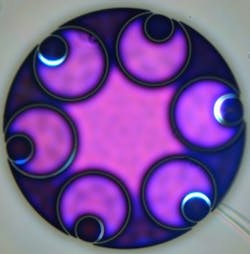Startup Lumenisity unveils hollowcore fiber cables for DWDM applications, new funding
Lumenisity Ltd. has emerged from stealth mode to tout its CoreSmart fiber cable based on hollowcore technology. The fiber-optic cable targets DWDM applications with reach above 10 km. The company also announced that it has received £7.5 million in backing from a consortium of investors.
As its name implies, hollowcore fiber technology uses air as a transmission medium within the fiber core rather than glass (or plastic, in the case of plastic optical fibers). Air offers less resistance to light than glass and doesn’t suffer the impairments typical of glass cores. As a result, says Lumenisity, data travels 50% more quickly in hollowcore fibers, which also offer a 1000X reduction in power-induced non-linear effects.
However, hollowcore fibers generally are difficult to manufacture economically in volume and present installation challenges. In addition, approaches such as photonic bandgap fiber are inherently multi-moded and thus subject to the deleterious effects of parasitic modes. Lumenisity says it has collaborated with the University of Southampton on the former issues to enable production of rugged cables that can be deployed in what the company calls “meaningful lengths” in metro network applications. The fiber is backward compatible with conventional fiber and fielded equipment. The company asserts that accredited installers can splice the CoreSmart fiber directly in the field to conventional fiber with commercially available splicers via the company’s patent-pending adapter technology.
As far as performance is concerned, Lumenisity says its patented nested anti-resonant nodeless fiber (NANF) approach enables single-moded hollowcore fiber that can support uninterrupted simultaneous single-mode transmission at 1310 nm, as well as over the full C and L bands “and beyond.” Fielded hollowcore fiber cables have shown losses of ~2 dB/km over a wide temperature range, Lumenisity adds.
The company says it has collaborated with customers and partners to deploy multiple cables globally that are carrying live production traffic – some for more than three years. The current deployments have shown the ability to handle multiple channels of 10 Gbps each with what the company calls “full broadband DWDM capability.” Lumenisity says tests at significantly higher data rates are planned over the next several months.
“The cables we have deployed from Lumenisity have exceeded our performance expectations,” commented Marcus Washco, global head of networks for Jump Trading, a trading firm that was an early user of the technology. “We selected Lumenisty as the best-in-class performing cable we are aware of and [with] an impressive near-term roadmap that will allow us to have much longer path lengths in our network.”
“This is the first of several announcements where we will be exploiting our patented and groundbreaking NANF technology to extend reach and bandwidth for our customers,” added Mike Fake, director responsible for product management at Lumenisity. “We are proud to be leading the field in bringing deployable hollowcore fiber technology to market with performance that can lead to real advantages for our customers in a variety of network applications.”
The company, formed in early 2017 as a spin out from the University of Southampton, also has announced the close of a funding round worth £7.5 million. The round includes a £5 million investment from BGF, with the remaining £2.5 million coming from Parkwalk. Lumenisity also said it received additional money from existing industrial strategic investors that it did not identify.
The company is headquartered in Romsey, UK, under the leadership of Chairman David Parker. Lumenisity’s academic founders include Professor David Richardson, deputy director of the University of Southampton’s Optoelectronics Research Centre (ORC; see "The University of Southampton AirGuide Photonics program to investigate holey fiber") Professor Francesco Poletti; and Professor Marco Petrovich. Parker, Fake, and Andy Appleyard are the industrial founders.
For related articles, visit the Optical Technologies Topic Center.
For more information on fiber cables and suppliers, visit the Lightwave Buyer’s Guide.
To stay abreast of optical communications technology, subscribe to the Enabling Technologies Topic Center.
About the Author

Stephen Hardy
Editorial Director and Associate Publisher, Lightwave
Stephen Hardy is editorial director and associate publisher of Lightwave and Broadband Technology Report, part of the Lighting & Technology Group at Endeavor Business Media. Stephen is responsible for establishing and executing editorial strategy across the both brands’ websites, email newsletters, events, and other information products. He has covered the fiber-optics space for more than 20 years, and communications and technology for more than 35 years. During his tenure, Lightwave has received awards from Folio: and the American Society of Business Press Editors (ASBPE) for editorial excellence. Prior to joining Lightwave in 1997, Stephen worked for Telecommunications magazine and the Journal of Electronic Defense.
Stephen has moderated panels at numerous events, including the Optica Executive Forum, ECOC, and SCTE Cable-Tec Expo. He also is program director for the Lightwave Innovation Reviews and the Diamond Technology Reviews.
He has written numerous articles in all aspects of optical communications and fiber-optic networks, including fiber to the home (FTTH), PON, optical components, DWDM, fiber cables, packet optical transport, optical transceivers, lasers, fiber optic testing, and more.
You can connect with Stephen on LinkedIn as well as Twitter.
